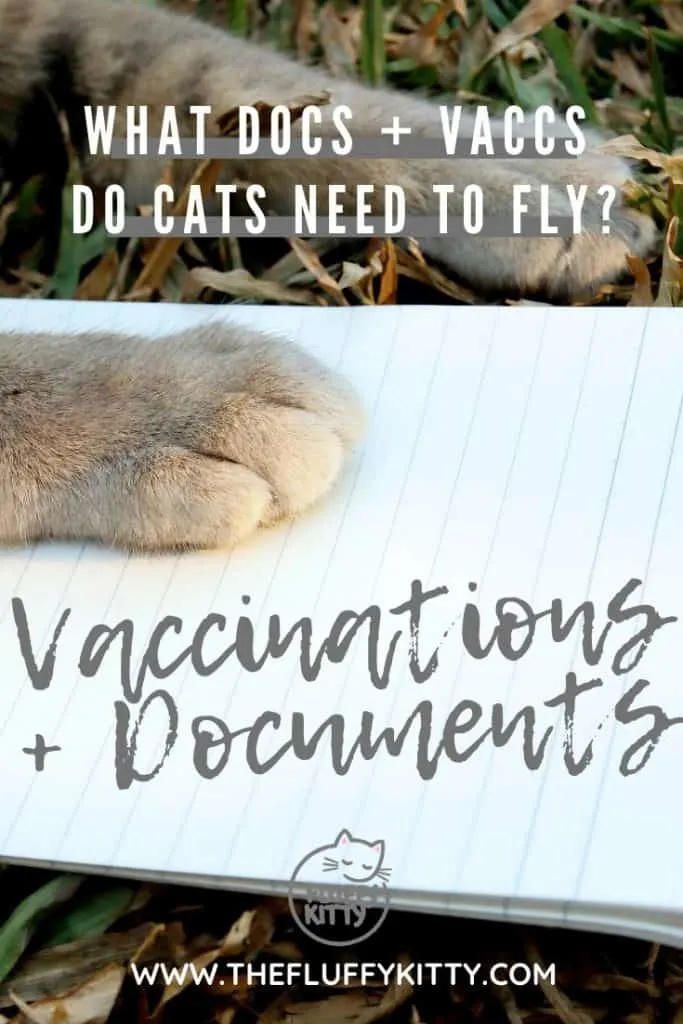Learn which essential documents and vaccinations cats need to fly in our complete guide.
Planning on flying with your cat? If so, there’s a handful of documents and vaccinations your cat will need before they can go airborne.
We have flown several times with our cat, Yoda, so we know the hassle it can be to get all the necessary papers together. This is why we include all the resources, documents, and vaccinations your cat will need to fly (to most countries) in this article!
Bon voyage! ✈️
Common Vaccinations Cats Need to Fly
Cats will need up-to-date vaccinations before they are able to fly.
If your cat is already vaccinated for everything, all you need to do is check the last vaccination date in case some are close to needing renewal.
The most common vaccinations your cat will need to fly are:
- Rabies Vaccination Feline* (For departures from the U.S. not required if entering the U.S, although recommended)
- Global/International Microchip (Most airlines and countries require this)
- FBR/C/P/Chlamydia Vaccination*
- Feline Leukemia Vaccination*
- Bordetella Vaccination*
- Fecal Examination
- Wellness Exam (In order to receive the Health Certificate which indicates your cat is fit to fly)
*These are the vaccinations and boosters our cat received before his first international flight.
Your cat might already have the vaccinations above but check for renewal dates. If they are close, we recommend speaking to your vet about going ahead and getting the booster vaccinations before your departure.
- International Health Certificate
- Microchip / Identification tag
- Rabies Certification
- Updated Vaccinations
- Flea/Tick/Parasite Treatment
Additionally, some countries might require further protocol, such as:
- Blood/Titer test
- Quarantine time
Required Documents for Your Cat to Fly
In addition to vaccinations, there are important documents your cat will need to fly.
Once your vet hands you the signed Health Certificate stating your cat is fit to fly, you will need to overnight ship this (with a pre-paid return envelope) to the nearest USDA APHIS office. Your vet will notify you which office is closest, depending on where you live.
For example, we went to the vet in Tennessee and overnight shipped the Health Certificate to the office in Florida, where a USDA officer signed and stamped the International Health Certificate and sent it back to us. This all must occur within 10 days of your departure date, so don’t procrastinate. I always pay for speedy 1-2 day shipping.
The second most important documents are the Rabies certification (original + copies), and copies of all updated vaccinations. Sometimes countries or airlines will require a Pet Passport.
Don’t depart for your trip without the original + copies of the rabies certification.
In Europe, it’s common for airlines or vets to ask about a pet passport, which is basically a small pamphlet detailing all your pet’s recent vaccinations and boosters, among other info.
Be wary of vaccination times. Kittens can get their first dose of the rabies vaccination as early as 8 weeks of age. That shouldn’t be a problem, however, as most airlines don’t allow kittens under 8 weeks (or even sometimes 12 weeks) to fly.
If you can, get the 3-year rabies booster to ensure your cat is covered for the entirety of your trip. Annual boosters are also possible but just check with your vet to be safe.
Make sure to get your cat vaccinated for their shots at least 4 weeks prior to your departure date because vaccinations take roughly 3 weeks to be effective and preventative.
This is why it’s so important to make two vet appointments:
- Schedule your pet’s appointment for vaccinations about 1 month before your departure date.
- The 2nd visit to the vet should be for the International Health Certificate (to be issued within 10 days of departure date).
Bring copies of everything with you when it’s time to fly, as the airlines will ask to see all documents and so will the country immigration officials. You don’t want to lose a copy!
The Best Online Resources to Check Pet Policies
Apart from our blog, there are several online resources for pet travel you should use to verify which documents you need for each country. I used these sites plenty of times when we began traveling with our cat.
To check which destination countries are rabies-free or are high-risk, use this resource here.
If you wish to check the protocol for importing a cat into the United States, check here. (Note: The CDC states you do not need a rabies certification).
Most importantly, you need to check the USDA APHIS website on pet travel here. This link lets you choose your destination country from a drop-down list which pops out all the country-specific information you’ll need to safely fly your pet.
Our advice? Use ALL of these resources to double-verify the information. Then, triple-check your info with both your vet and your airline.

Getting the Documents & Vaccinations at Your Local Vet
So what comes first? Documents or vaccinations?
As I mentioned above, make sure to get your vaccinations in order before the documents.
Vaccinations have a time-stamp that countries and airlines look closely at. You don’t want to miss your trip because your cat’s vaccination was administered too late! (This ALMOST happened to us!)
✅ Make a vaccination appointment for your cat as early as 4 weeks prior to your departure date.
While at the vet, make sure to verify all the information you collected from your research. The vet might have specific advice to give you.
Ask the vet to make a copy of any vaccinations or certificates for you.
The rabies vaccination certificate is the most important, as this is a specific certificate.
As for the other vaccinations (like Feline Leukemia), just print out or scan extra copies from your vet bill. The information you will need visible is 1.) the date of each vaccination 2.) your cat’s information and 3.) your name or visibility of ownership.
I found while traveling that having the dates clearly visible, along with me and my cat’s identification, helped speed up the verification process for airlines and country officials.
✅ As for the documents, focus on getting the International Health Certificate signed from your vet and also signed from a USDA APHIS officer.
Personally, I recommend you schedule the Wellness Exam (for the Health Certificate) 8 or 9 days before your departure date (up to 10 is the limit).
Why 8 or 9? Because the Health Certificate is valid for only 10 days, you don’t want to get caught in an unfortunate situation in case your flight was to be delayed by a day, resulting in your certificate expiring.
The USDA APHIS office will send your cat’s signed Health Certificate back to you typically within 1-3 days. The time depends on the pre-paid service you paid for. Always opt for the overnight or 1-2 day shipping if you can.
(If I remember correctly, the shipping fee round-trip from Tennessee to Florida cost us around $50).
Once you receive it back, make copies and take pictures of it just in case and verify that all the information is correct.
The Process for Getting the Health Certificate
The process for obtaining the International Health Certificate for your cat can be confusing. So I’m going to clarify again here because it is really important to plan this right the first time.
Step 1: Research
Use the resources I linked in this article to check what documents and vaccinations you need. The International Health Certificate is probably going to be on that list, although there could be exceptions.
Step 2: Schedule your vet appointment
So you have your flight’s departure date – great! Now, call your vet and ask them about scheduling you in because you’re flying with your cat and you need a health certificate.
Make the appointment for 8-9 days BEFORE your departure date. No later than 10 and no sooner than 5, if possible (to be on the safe side).
Step 3: At the vet
Your vet will fill out the health certificate, likely in front of you. Verify that your pet’s information is correct (name, weight, breed, etc.), along with your address, name, etc.
The vet will give you the health certificate. Ask any other questions at this time.
Step 4: Go to FedEx right after
To ensure you don’t procrastinate, walk into a FedEx store right after your vet appointment. Ask at the counter for a pre-paid envelope with the return address.
Fill out the information and send to the address for the USDA APHIS office your vet provided you. Pay for the overnight return shipping or express shipping for 1-2 days. Remember, this is for both ways so don’t cut corners. You need that document back on time!
Step 5: Track your envelope and wait for a phone call
Each time we’ve waited on the signature from the USDA APHIS officer, we received a phone call from the department.
At this time, we paid the fee (yes another fee) over the phone via debit card, and the officer verified the information with me.
The officer will then prioritize shipping your envelope back to you.
And done!

Expert Tips for Preparing for Your Trip
Hooray! By now, you should have all the information regarding which documents and vaccinations your cat needs to fly. 🙂
Here are some final tips for preparing to fly with your cat we think will be useful for you.
Choosing the Right Airline for Your Cat
Have you already booked your flight? If not, check out our ultimate guide on the best airlines for cats. In it, we detail the 12 most popular airlines for flying with cats. You can also check for under seat dimensions and each airline’s pet fee for cabin and cargo travel.
Choosing the Right Cat Travel Gear
Flying with cats means flying with the right travel gear. If you’ve never flown before, following airline’s pet policies can be confusing. You’ll want to check with each airline to determine what size cat carrier you’ll need.
We personally use the Amazon Basics soft-sided cat carrier, which is a simple, no-frills carrier for under $30.
Yoda has flown in it about 3 times now and has plenty of space to lie down comfortably (size L).
In addition to a carrier, make sure your cat has adequate accessories. A collapsible food/water bowl is convenient and important for keeping your cat hydrated and fed while traveling.
For travel in-cabin or in cargo, your cat’s carrier should be lined with an absorbable pee pad. You can check what else your pet’s carrier needs in our article on flying with pets overseas here.
Training Your Cat to Fly Well
How exactly do you train your cat to fly in a plane?
Well, with practice.
The best way to acclimate your cat for plane travel is by traveling with your cat in general. Even if it’s by car, frequency and familiarity go paw in paw when it comes to flying with your cat.
The single most important training tool to utilize is your cat’s carrier. Training your cat to enjoy their carrier (i.e. sleeping in it) will help your cat adjust to being in the air.
It’s simple: if your cat hates the carrier, they will definitely hate flying. If your cat doesn’t mind the carrier, well, it’ll be a lot easier and less stressful for your cat.
Going Through the Airport with Your Cat
Airports are crawling with busy people and loud, sudden noises. It can be stressful for some cats to be in such an environment, especially as you go through airport security.
Option 1: Security check as normal
If your cat is not anxious, you can go through security as normal. The officer will ask you to take your cat out and hold it as you walk under the x-ray machine and will swab one of your hands.
Option 2: Private security screening
If your cat is stressed and is unwilling to come out of their carrier, you can ask a TSA agent for a private screening. They will take you into a closed, quiet room to check you there and swab your hands.
Once past security, go find a quiet corner and relax at your gate with your cat. Don’t forget to bring a small bag of treats to encourage your feline.

In-Flight Tips to Keep Your Cat Calm
If you can, board last so your cat won’t stress out with everyone shuffling past your seat. Once in the plane, gently place your cat under the seat in front of you.
PRO TIP: Face your cat’s head at and in between your feet, so you can easily pop your hand inside and give them a quick rub to comfort them.
If your cat is meowing, comfort them with chin tickles and tasty treats, but don’t take them out of their carrier. After takeoff, you can give them some water in their travel bowl.
Cats or any pets should never be sedated during travel. Read more about the harmful effects of sedation here.
Final Thoughts: What Documents & Vaccinations Does My Cat Need to Fly?
Getting the necessary documents and vaccinations cats need to fly can be tricky, but not impossible!
Just make sure to thoroughly do your research, contact your vet early, and confirm the information you have with your airline.
We know it can be stressful, but try not to communicate that to your cat! The flight will go smoothly, we promise. xoxo
Feel free to send us your questions and comments about your travel plans with your cat!

